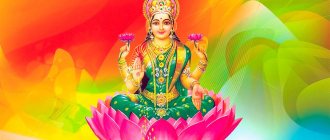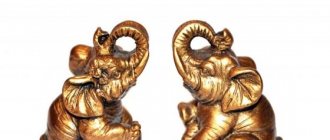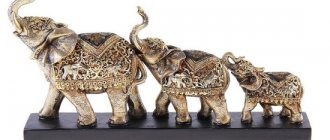Ganesha, or Ganapati (Sanskrit: गणेश; Gaṇeśa IAST; pronunciation (inf.)) is the deity responsible for wisdom and well-being. He is considered the most famous and revered god in the Hindu pantheon.
Sri is added to his name as a symbol of special respect. The chanting of Sahasranama in honor of the deity (Sanskrit: गणेश सहस्रनाम, “a thousand names of Ganesha”) is often used as worship, each of these names highlighting one aspect of the god (Ganapathi Sukta).
Meaning
Ganesha is the god of luck. Among his names, the most famous are: Ganapati, Vigneshvara, Vinayake, Pillayar, Binayak, etc.
The word “Ganesha” itself includes two separate words: “gana” (group, unity of many) and “isha” (god, teacher). The name "Ganapathi" can also be broken down into "gana" (some community) and "pati" (ruler).
The demigods (gana-devatas) were called Ganas; they were Shiva’s assistants and were headed by Ganesha. All demigods can be grouped into 9 classes: Adityas, Vishvadevs, Vasus, Tusitas, Abhasvaras, Anilas, Maharajikas, Sadhyas, Rudras.
The very first mention of the name "Ganapathi" is found in the Veda of Hymns (2.23.1).
The Sanskrit lexical dictionary of terms "Amarakosha" (authored by the sage Amara Sinha) calls Ganesha by the following names : Vignesha, or Vignaraja, Vinayaka and Vigneshvara (getting rid of obstacles), Dvaimatura (born of two mothers), Ganadhipa, Ekadanta (having one tusk), Heramba , Lambodara and Mahodara (with a full belly), Gajanana (elephant-faced), Dhavalikar (quickly included in the pantheon of gods).
The name Vinayaka is also mentioned in the names of eight Hindu temples in Ashtavinayak (Maharashtra state). Pilgrims from all over the world often gather in these sacred places to visit the temples in a specific order. All eight structures in honor of Ganesha are located around the city of Pune. Each of them has its own legend and history. The form and manifestation of the deity in the temples also differs from each other.
The Yatra (pilgrimage) is recommended to be carried out in the following order:
- Mayureshwar in Morgaon;
- Siddhivinayak in Siddhateka;
- Ballaleshwar in Pali;
- Varadavinayak in Mahad;
- Chintamani in Theura;
- Girijatamaj in Lenyadri;
- Vighnahar in Ozar;
- Mahaganapati in Ranjangaon.
Albino elephant - a shrine of Asia
In many countries where the population professes Buddhism, the elephant can be considered a people's favorite. This is especially clearly reflected in the life of Thailand.
Here, images of giants can be found almost everywhere: in the decoration of apartments, the interiors and exteriors of temples, street sculptures, paintings by local artists, souvenirs, and landscape design.
These animals are a symbol of royal power and its unity with the people and religion. When a white elephant calf is born in a country, the event becomes the property of the entire kingdom, and the monarch takes the baby into the care of his court.
The name
of the highest award that can be awarded to a Thai citizen or military officer is the Order of the White Elephant. The order is decorated with gems and made of expensive metal.
Thailand and neighboring Cambodia and Myanmar also consider the animal to be the patron of rain and fertile soil. The Chinese associate it with long life, good energy, and caution.
Image
The image of Ganesha is inextricably linked with a humanoid creature who has the head of an elephant and one tusk . He usually has four arms.
The deity rides on a rat (vahana), which symbolizes sensual manifestations and selfish interests subordinate to Ganesha.
Why does the deity have an elephant-like face? The fact is that he lost his head after birth. God Shani (Saturn) did not look at the child when he was born. This is due to the curse placed on him, due to which everything he looked at became dust. Goddess Parvati insisted that Shani still look at the baby and his head disappeared. God Shiva began to look for a new head for his son. Brahma advised to take it from the first creature you meet, who sleeps with his head to the north. It turned out to be an elephant named Airavata, who is Indra’s vahana.
One of Ganesha's tusks was broken during a fight with the giant Gajamukha. When he touched the tusk, under the influence of incredible force he turned into a rat (vahana).
There is another legend that talks about the use of Ganesha's tusk as a pen for writing Vyasa's Mahabharata.
Most often, the deity has four hands, clasping the following attributes:
- an ax (eliminating attachment to everything material, it is also a symbol of power);
- lasso or hook (limiting and controlling one’s selfish desires);
- trident (personification of power);
- lotus (symbol of spiritual enlightenment);
- a broken tusk in her lower right hand, but in some images her fingers are folded into a protective abhaya mudra.
The number of hands can be more or less than four (from 2 to 16). Often in the drawings you can see the deity dancing, which symbolizes prosperity and wisdom.
Legends
The legends about the elephant-like face of the god differ from each other. Thus, in the Puranic texts there are descriptions of a deity who was originally born with an elephant’s head. Other tales tell of the acquisition of a new head after birth, and before that the deity looked like an ordinary person.
The Shiva Purana tells that Ganesha was born by Parvati as a gatekeeper for her own palace. She needed a guard during her ablutions so that no one could disturb her privacy and enter her chambers. Legend has it that Ganesha emerged from Parvati's sweat. The special qualities of the deity were his power and valor. Even Shiva could not get close to his wife. He ordered the faithful Ganas to drive his son away from Parvati’s chambers, but he fought bravely and was able to resist the warriors. This was a landmark battle for the Hindu pantheon, since all the gods participated in it along with Vishnu.
Ganesha did not give up. Then Shiva cut off his son’s head with his own hands. Parvati was furious and wanted to bring down a flood on everyone who fought with her son. The gods, sensing the scale of the destruction, turned to Parvati with a request to stop. But the only thing they had in their power was to bring Ganesha back to life.
Shiva directed the gods to find a new head for his son, ordering it to be cut off from the first person he met. It turned out to be an elephant. And the deity’s broken tusk appeared already during the second incarnation, when he was called Ekadant (a legend from the Mudgala Purana).
Some drawings depict a snake. She represents energetic transformation.
The Ganesha Purana describes the appearance of the snake as follows: it was wrapped around the neck of Ganesha by the gods and asuras when the milky ocean was churning. The same legend talks about the design of the tilaka sign or crescent on the forehead of Ganesha. In this case he is called in this case he is called as Bhalacandra, one of the 12 names of Ganesha. Reference! Ocean churning is the process of churning ocean waters in order to extract the drink of immortality, amrita.
There is no single list of treasures obtained from the ocean. The rat-vahana also appeared not by chance. The Mudgala Purana talks about four incarnations of the deity in which he rode on different animals:
- shrew;
- lve (Vakratunda);
- peacock (Vikata);
- Sesu - the snake (Vighnaraja);
- horses (Dhumravarnu).
The Ganesha Purana mentions other vahanas of the deity:
- peacock (Mayureshvara);
- lion (Mahatkata-Vinayaka);
- horse (Dhumraketa);
- rat (Gajanana).
But it is the rat that is considered the main means of transportation for Ganesha. This is due to the fact that, according to Hindu canons, the mouse symbolizes tamo guna - desires that must be limited if a person strives for spiritual self-development (getting rid of selfish manifestations). Ganesha, controlling the rat, copes with all difficulties on the Path of spiritual growth. His other names (Vignesvara, Vignaratha, Vignaraja) contain the power necessary to destroy obstacles. Although, he himself is the reason for their appearance. He is able to present lessons in the form of difficulties for spiritual growth. By overcoming them, a person becomes one step higher in self-improvement.
The appearance of an elephant contains the strength and power of a rebellious, difficult-to-control creature. When an elephant is restrained with the ankus (trainer's tool) and rope, it means restraining one's senses and the gross material aspects of one's personality. In this way, obstacles on the spiritual Path that appear due to selfish thoughts can be eliminated. At Ganesha’s feet there is usually a cup with various sweets (modaks) - this is a symbol of enlightenment, which the spiritual seeker so craves.
Legendary meditation course without payment We recommend! The most popular meditation course for beginners in Russian. More than 100 thousand people have already learned to meditate. Try it yourself. Read more.
For offerings, it is best to use 21 sweet balls (modaki) prepared by yourself. This is Ganesha's favorite number.
Buddhist animal
In Buddhism, elephants are one of the most revered animals. This is not surprising, because they are a symbol of the most beautiful features of the human soul, character, and mind:
- spiritual growth;
- love for all living things, kindness, empathy;
- calm mind, tranquility;
- balanced decisions, stability;
- knowledge, worldly wisdom.
Particular respect is paid to the white elephant, which reflects purity combined with virtue. But at the same time, such an animal will not allow every person to approach it. You need to be prepared spiritually in order to get closer to him, to cultivate in yourself the missing qualities from the list.
Previously, white elephants could only be kept by kings, prominent politicians, and holders of empires.
The animals were given unprecedented care: they were nursed by nurses, rubbed with fragrant oils and ethers, given floral and herbal water to drink, dressed in clothes made of expensive fabrics, they did not skimp on jewelry made of precious metals and stones, and were hidden from the sun's rays.
This kind of all-encompassing love has its origins in the Buddhist tradition. The white elephant represents the bodhisattva's companion who sacrifices himself for the liberation of others.
He is the totem animal of the bodhisattva, his mode of transportation is vahana, which means Jewel of the Law.
The revered Akshobhya, one of the five Buddhas of wisdom, is depicted sitting on an elephant. Moreover, there is a version that Buddha Shakyamuni himself in one of his incarnations was an albino elephant.
Indian god of wisdom
Shri Ganesha - akasha-abhimani-devata - is a deity who is able to control the secondary ether (bhuta-akasha), produced under the influence of the guna of tamas. It combines the five primary elements of creation, and it also becomes the cause of the birth of false egoistic manifestations. He is significantly influenced by the god Shiva. Hearing is most closely related to the secondary ether. With the help of the ears one can perceive sound vibrations existing in the ether.
It should be recalled that Vedic knowledge was initially passed down from generation to generation orally. Ganesha is also known as the patron of knowledge (buddhi). In legends he is credited with high mental and intellectual abilities. One of the names of the deity is translated as “lover of knowledge” (Buddipriya), where “priya” means “lover” and “buddhi” means “knowledge”. If Ganesha blesses, then a person will be able to move to a new stage of spiritual development.
There is a well-known legend that the deity wrote down the text of the Mahabharata under the dictation of Vyasa, each verse of which has not only a direct meaning, but also ten hidden meanings. Secret knowledge is available only to those who can comprehend Vedic truth.
What kind of deity is this
Deity Ganesh, otherwise called Ganapati, is easy to remember due to his extraordinary appearance. It has the body of a man and the head of an elephant. Ganesha is considered the patron saint of those people who lead a righteous life, do not forget to pray and have bright thoughts. He directs all his kindness and favor to such people.
In his homeland, Ganapati, the god of prosperity and wisdom is one of the spirits that is especially revered by Indians. They show their respect by adding the prefix Sri to the name of the deity. Dancing Ganesha is the son of the supreme god Shiva and his wife, the daughter of the king of the mountains, Parvati. Ganesha's consorts are two goddesses: Buddhi, who rules the mind, and Siddhi, who controls success.
Ganapati's trunk is endowed with extraordinary power, with the help of which the deity can remove any obstacles, clearing the way for those who want to reach the top in any matter.
Family
Ganesha was born into the family of the god Shiva and the goddess Parvati. But the story of his birth is very contradictory in the Puranic myths. There is a version that the creator of the deity was Shiva, and in another version - Parvati. There is also a legend about the incomprehensible birth of Ganesha and his adoption by his new parents Shiva and Parvati.
His brother is called Skanda (Kartikeya, Murugan). Moreover, the northern part of India sees Skanda as the eldest of the brothers, and the southern part sees Ganesha.
It is known about Skanda that he was a warlike god and existed from the 5th century BC. e. to the 6th century AD e. When the worship of Skanda began to decline, the number of Ganesha worshipers increased sharply.
There is no consensus about the family ties of the deity. Some myths glorify Ganesha as a brahmacharya who cannot have a wife. This opinion is especially widespread in the southern part of India and partially in the northern part.
Another version says that Ganesha possessed the three ideas of buddhi (intelligence, reason), siddhi (success) and riddhi (prosperity). These same ideas correspond to the wives of the deity of the same name.
Third version: Ganesha's wife is the goddess Saraswati , who is responsible for art and culture, or Lakshmi, who is in charge of good luck and prosperity.
Ganesha and the mouse
According to one interpretation, the sacred vehicle of Ganesha, the mouse or Mushak, expresses wisdom, talent and intelligence. It symbolizes instant revelation in the exploration of encrypted messages. The mouse spends a hidden life underground, therefore it is also a symbol of ignorance, which dominates the darkness and is afraid of light and knowledge.
Being the vehicle of Lord Ganesh, the mouse teaches us to always be alert and bring out what is hidden within us with the light of knowledge.
Both Ganesha and the mouse love modak, a sweet treat traditionally offered to them during worship ceremonies.
Mushak is usually depicted as very small in comparison to Ganesha, unlike depictions of the charioteers of other deities. However, at one time it was traditional to depict Mushak in Mogarish art as a very large mouse, and Ganesha rode on it like a horse. According to another interpretation, it is argued that the mouse (Mushika or Akhu) expresses the ego, the spirit with all its thoughts, human pride . Ganesha, riding the mouse, becomes the master of all these aspirations, showing the power that the mind and mental faculties have over the spirit.
Moreover, the mouse (being extremely insatiable by nature) is often depicted next to a plate of sweets, with its eyes turned towards Ganesh, as if awaiting an order from him, while he firmly holds a piece of food in his hands. This symbolizes a spirit that is completely subservient to the higher faculty of intellect and this spirit is under the control of Ganesh, who will not give permission to eat until permission is given.
Yantra
The Ganesha Yantra is depicted as a geometric structure that is capable of emitting special protective energy. Yantra helps to remove any obstacles to spiritual and personal development. It is best to place it in the north-eastern part of your home. Before starting business, you need to turn to this yantra with pure intentions. Then everything will work out and help will come from Ganesha in the form of eliminating possible obstacles.
Mudra
God Ganesha will give self-confidence and courage to those who master how this mudra is made. Performing mudra opens the bronchi, improves cardiac activity, strengthens the heart muscles and removes imbalances of energy in the area of these organs, affecting the 4th chakra.
The exercise is performed like this:
- The left hand is placed in front of the chest. Moreover, the inner side of the palm needs to be turned outward.
- Bend the fingers of the left hand.
- The right hand is placed with the back side outward and the fingers interlocked with the left.
- Hands are lowered to heart level.
- Inhale and at the same time, with effort, without releasing your fingers, pull both arms to the sides. There will be a feeling of tension in the muscles of the chest and upper arms.
- When you exhale, you relax your muscles.
- Repeat the exercise 6 times and then place your hands on your chest, as if launching the energy of love in your heart and concentrating on your feelings.
- Change the position of the hands and repeat the exercise 6 times.
After completing the exercise, you need to be alone for some time. It is enough to repeat the mudra once a day.
Mantras
In the modern world, people often turn to Ganesha to improve their financial well-being. There is a lot of information on the Internet that you just need to sing a mantra in honor of the deity, and money will start coming into your wallet just like that. But this is an unwise approach. You can't address gods like that. It is important to remember that everyone has in this life exactly as much as they really need to help the living beings around them. When turning to God there should be no selfish, selfish thoughts. When the heart radiates the energy of love, kindness, purity and sincerity, only then will the gods hear and grant mercy.
Ganesha is able to help those who have pure intentions. To contact him, you should recite the mantras:
"Om Gam Ganapataye Namaha"
"Om Kshipra Prasadaya Namaha."
In the last mantra the word "Kshipra" is translated as "instantly". This mantra will help you find a way out of an emergency situation, in case of danger or manifestation of negative energy towards a person. During its utterance, a blessing occurs and deliverance from negative vibrations in the personal energy space.
Hidden meaning of Ganesha's body parts
Every part of the body of the immortal Ganapati has a meaning. The elephant's head represents the deity's prudence, constancy and devotion. The ears confirm the kindness of the spirit, symbolizing its endless nobility and desire to help those who need it.
The tusk symbolizes the focus on struggle, the desire to overcome the duality of human nature, to defeat its negative side, characterized by laziness, quarrelsomeness, anger and other destructive qualities.
A long trunk speaks of the high intellectual abilities of the deity. Ganesha was given a big belly as a sign of his generosity and generosity.
The Ganesha talisman will protect and help a person who wants to gain confidence and happiness.
Functions
- Shaivism assumes the role of the supreme god Parashiva - the creator, destroyer, defender of truth, conqueror of demonic forces, giver of goodness and ruler of the entire Universe, all other deities are subordinate to him;
- in Hinduism, Shiva is considered the destroyer of all things: when the world cycle (Mahayuga) comes to an end, he will clear the space to create a new world;
- he is known as the creator of the sound “OM”, as well as Sanskrit and pagan cult;
- this deity also has healing power, it is able to deliver from death (Mahamrityunjaya);
- his retinue includes spirits and demonic forces that follow him on his heels at will.
Statuette
According to Feng Shui philosophy, an elephant figurine will bring good luck to your home. In an apartment, it is best to place the figurine in the northwest or southeast. Most often, such a talisman has a curved trunk, majestically facing upward. There are figurines with the proboscis pointing downwards.
The meaning of a figurine with a raised trunk
Such a symbol will attract financial wealth and good luck, help maintain calm in any troubles in life and establish peace in the family.
An elephant with its trunk raised symbolizes:
- victory over evil forces;
- material abundance in the family;
- success in any endeavor;
- prudence.
The most favorable location for the figurine is a window sill in the southwestern part of the apartment. The talisman is placed with its trunk towards the street so that it “draws in” positive energy. Positioning the trunk inside the room is acceptable when everything is fine in the house.
The talisman can also be placed in the northwestern part of the home - this helps to gain powerful friends and benefactors. A suitable place for a pair of identical elephants would be a matrimonial bedroom. The figures should be placed on the sides of the bed. Thanks to their presence, harmony, love and harmony will reign in family relationships.
People who want to have children need to purchase two animals with intertwined trunks. Such figurines are also installed on the sides of the front door facing those who enter the apartment. They will protect their owners from enemies and the evil eye.
The figurines are able to cleanse your home of negative energy. To do this, they are placed in places where negativity accumulates: in the corners of the house and in the kitchen.
The meaning of a figurine with a lowered trunk
This amulet is suitable for those who dream of a child. It is better to have two elephants and place them on both sides of the bed. One of them will have a beneficial effect on male strength, and the second will have a beneficial effect on a woman’s ability to conceive.
In addition, it is recommended to place the figurine in the western part of the apartment, which according to Feng Shui is considered a children's zone.
An elephant with its trunk down symbolizes:
- the opportunity for holders of such a figurine to become parents;
- fertility;
- motherhood.
A figurine depicting a mother elephant with a baby elephant will help when trying to have children.
Color meaning
The material from which the figurine is made does not matter. But you should not use ivory items . They will have the opposite effect.
The white elephant is a talisman for protecting the family hearth from dark energy and evil spirits. It is a symbol of love, eternity and wisdom. In all countries of Southeast Asia, he is revered as a bearer of good luck.
Gold coins with the image of an elephant promise wealth and independence. According to Chinese numerology, the three figurines represent the unity of man with heaven and earth. In addition, the trinity symbolizes power and orderliness. It is better that all three are the same color.
It is not recommended to place the elephant together with other Feng Shui talismans, as this will weaken the effect of each of them.
Seven elephants: what does it mean?
A group of seven elephants of different sizes is considered one of the most powerful talismans. In the USSR, such figurines, arranged according to height, were usually placed in sideboards and display cases. They were given “for good luck.”
Main destination:
- strengthening marriage;
- monetary well-being;
- amulet against ill-wishers, protection against theft.
Seven in numerology is a magical number, found in all religions, it means:
- wisdom, education, philosophical attitude to life;
- perfection, harmony, cosmic and spiritual order;
- a completely completed cycle (each phase of the Moon lasts seven days);
- seven days of the week;
- seven colors of the rainbow;
- seven space eras;
- seven wonders of the world, etc.
If desired, the effect of the talisman can be enhanced. What elephants like most is jewelry. You can hang bracelets made of natural stones, beads or a chain on it. It will definitely thank its owner and bring him good luck.
Of course, ivory products cannot be used for these purposes, because they are associated with the suffering of the animal. The elephant is vindictive and can take revenge for the insult of its relative.
Festive procession
Here in Thailand, an elephant festival has been held every year for more than half a century. Amazingly dressed giants parade through the square, accompanied by drivers who have become masters in their unusual profession.
The procession ends with songs, dances, burning lambadas, aerial paper lanterns and rituals, meditative practices, and reading mantras.
The holiday falls on the third Saturday of November. In 2021 it will be November 17th.
The unique procession is associated with the teachings of Buddha. In one of his sermons, he said that a wild elephant is put in the same harness as a trained one in order to train it. This is what we need to do when we take the path of truth: we should join a guru in order to comprehend the Dharma.
Great sweet tooth
Ganesha
According to tradition, Ganesha is very fond of a sweet dish - rice balls prepared in a special way with a sweet filling. As the legend goes, during one of his birthdays, the god visited one house after another, where he was treated to various sweets. He ate a countless number of them and went on a night trip looking at his mouse. The latter suddenly tripped and the god fell. Ganesha's belly opened and all the food he had eaten fell out. But our god did not despair. He shoved them all back in, then took the snake and used it as a rope. Luna looked at all this and was amused by this behavior. Ganesha, noticing the joy of the heavenly body, became very angry, he took one of the fangs and threw it at the Moon, saying that now no one should look at it on the Ganesh Chaturthi holiday.
Lowest, but not the last
The described Indian god Ganesha is the leader of the lower pantheon in the retinue of Shiva, but this does not make him less popular. The god of wisdom, the removal of obstacles, he is greatly revered. Helps people who are involved in crafts, business, various sciences, and creative people. Like the husband, his wives Buddhi and Siddhi also perform similar functions.
At all times and to this day, Ganesha is called upon when an important task needs to be started. Many works in Sanskrit begin with an appeal to this particular deity. There is even a separate Ganesh Purana, which is completely dedicated to him.
Ganesha temples are very popular. The 4th day of the bright half of the month - chaturtti - is especially revered, and in the month of Bhadra (August-September) in Maharashtra, the Ganesha festival is celebrated for 10 days.











